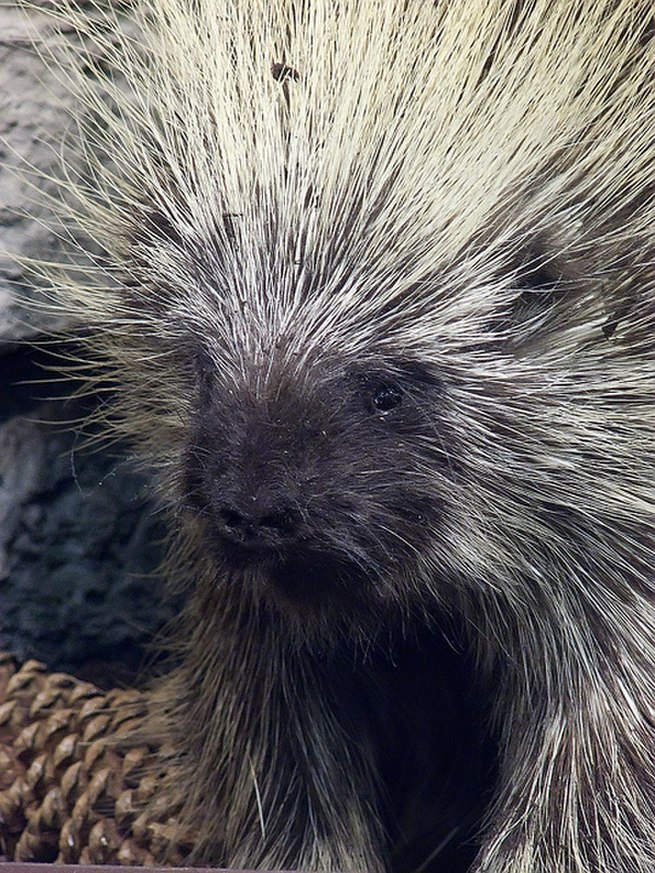
Main Difference
The main difference between Porcupine and Hedgehog is that the Porcupine is a rodent with a coat of sharp spines and Hedgehog is a small spiny mammal.
-
Porcupine
Porcupines are rodents with a coat of sharp spines, or quills, that protect against predators. The term covers two families of animals, the Old World porcupines of family Hystricidae, and the New World porcupines of family Erethizontidae. Both families belong to the infraorder Hystricognathi within the profoundly diverse order Rodentia and display superficially similar coats of quills: despite this, the two groups are distinct from each other and are not closely related to each other within the Hystricognathi.
The Old World porcupines live in southern Europe, Asia (western and southern), and most of Africa. They are large, terrestrial, and strictly nocturnal. In taxonomic terms, they form the family Hystricidae.
The New World porcupines are indigenous to North America and northern South America. They live in wooded areas and can climb trees, where some species spend their entire lives. They are less strictly nocturnal than their Old World relatives, and generally smaller. In taxonomic terms, they form the family Erethizontidae.
Most porcupines are about 60–90 cm (25–36 in) long, with an 20–25 cm (8–10 in) long tail. Weighing 5–16 kg (12–35 lb), they are rounded, large, and slow, and use aposematic strategy of defense. Porcupines occur in various shades of brown, gray, and white. Porcupines’ spiny protection resembles that of the unrelated erinaceomorph hedgehogs and Australian monotreme echidnas.
-
Hedgehog
A hedgehog is any of the spiny mammals of the subfamily Erinaceinae, in the eulipotyphlan family Erinaceidae. There are seventeen species of hedgehog in five genera, found through parts of Europe, Asia, and Africa, and in New Zealand by introduction. There are no hedgehogs native to Australia, and no living species native to the Americas (the extinct genus Amphechinus was once present in North America). Hedgehogs share distant ancestry with shrews (family Soricidae), with gymnures possibly being the intermediate link, and have changed little over the last 15 million years. Like many of the first mammals, they have adapted to a nocturnal way of life. Hedgehogs’ spiny protection resembles that of the unrelated porcupines, which are rodents, and echidnas, a type of monotreme.
The name hedgehog came into use around the year 1450, derived from the Middle English heyghoge, from heyg, hegge (“hedge”), because it frequents hedgerows, and hoge, hogge (“hog”), from its piglike snout. Other names include urchin, hedgepig and furze-pig. The collective noun for a group of hedgehogs is array.
-
Porcupine (noun)
Any of several families Hystricidae (Old World porcupines) or Erethizontidae (New World porcupines), both from the infraorder Hystricognathi, noted for their sharp spines or quills, which are raised when the animal is attacked or surprised.
-
Hedgehog (noun)
A small mammal, of the family Erinaceidae or subfamily Erinaceinae (pl=s, the latter characterized by their spiny back and often by the habit of rolling up into a ball when attacked.)
-
Hedgehog (noun)
Any of several spiny mammals, such as the porcupine, that are similar to the hedgehog.
-
Hedgehog (noun)
A type of moveable military barricade made from crossed logs or steel bars, laced with barbed wire, used to damage or impede tanks and vehicles; Czech hedgehog.
-
Hedgehog (noun)
A spigot mortar-type of depth charge weapon from World War II that simultaneously fires a number of explosives into the water to create a pattern of underwater explosions intended to attack submerged submarines.
-
Hedgehog (noun)
A type of chocolate cake (or slice), somewhat similar to an American brownie.
-
Hedgehog (noun)
A form of dredging machine.
-
Hedgehog (noun)
Certain flowering plants with parts resembling a member of family Erinaceidae
-
Hedgehog (noun)
, the pods of which are armed with short spines.
-
Hedgehog (noun)
A kind of electrical transformer with open magnetic circuit, the ends of the iron wire core being turned outward and presenting a bristling appearance.
-
Hedgehog (noun)
A way of serving food at a party, consisting of a half melon or potato etc. with individual cocktail sticks of cheese and pineapple stuck into it.
-
Hedgehog (verb)
To make use of a hedgehog barricade as a defensive maneuver.
-
Hedgehog (verb)
To array with spiky projections like the quills of a hedgehog.
-
Hedgehog (verb)
To curl up into a defensive ball.
-
Porcupine (noun)
a large rodent with defensive spines or quills on the body and tail.
